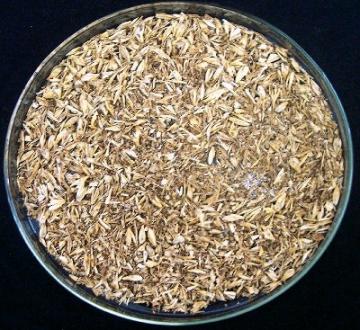
Brewer’s grain is the material that is remaining after grains have been fermented during the beer making process. These materials can be fed in the un-dried form (wet brewer’s grains) or dried (dried brewer’s grains) and fed. The nutritional content of the material will vary from plant to plant and depending upon the type of substrate being used (barley, wheat, corn, etc.), proportions being fermented and fermentative process being used. Some plants will dry the brewer’s grain and sell it as dried brewer’s grain, while others will have it available as wet brewer’s grain. Both types have similar feeding characteristics if the wet brewer’s grain is fed shortly after it is produced. Although the rumen degradability of the protein in the dried
Nutritive value
Dried brewer’s grains contain 27-30% protein and 65% TDN. They are an excellent source of high quality bypass protein and digestible fiber. Dried brewer’s grains have a good amino acid, mineral and B-vitamin contents. Lysine is normally the most limiting amino acid and it is a good source of water soluble vitamins. Brewer’s dried grain usage is limited in monogastric animals, because of its high fiber (24% ADF) content.
Inclusion level
Suggested feeding levels are 30-40% of the ration for dairy cows. The wet brewer’s grains are normally fed fresh, but can be ensiled. If ensiled, the quality of the resultant silage can be improved by adding a readily fermentable carbohydrate source (molasses, cereal grain, etc.) that will accelerate the fermentation rate, which results in more acids being produced and a more stable silage. Packing and ensiling characteristics can be improved by blending the wet brewer’s grains prior to ensiling with other material that are dryer (forage, bran, hulls, etc.). If wet brewer’s grains are ensiled alone then excessive runoff may occur, so it is best to ensile it in a silo with proper drainage. If fed as wet brewer’s grains care needs to be taken to assure that it does not deteriorate prior to being fed. Since the wet brewer’s grain is an excellent media for microbial growth and has been shown to support the growth of yeast and mold, it is best to feed the material as soon as possible after receiving it.
It is better to not store the material much longer than a week to 10 days prior to feeding it; this is especially true in hot or warm areas. In general, wet brewer’s grain could be stored for 10 days in Spring, 5 days in Summer and 30 days in Winter. If storing for longer periods of time the material should be ensiled. Under hot and humid conditions it might not be possible to store the material for a week. Storing in a shaded or cool place will lengthen the time that the wet brewer’s grains can be stored. Covering the surface with plastic or some other covering material will minimize surface spoilage and timelength that the material can be stored. Various methods to preserve wet brewer’s grain have been evaluated. Feed consumption will be reduced if spoiled brewer’s grain is fed. Feed mixtures containing brewer’s grain will spoil quite rapidly, so any excess feed that animals have not consumed should be removed and discarded. The palatability of wet brewer’s grain will decline with increasing storage time.
When fed to dairy cattle off-flavors in the milk can be avoided by feeding the cows after they have been milked instead of before. It is best to feed wet brewer’s grain fresh, since it will sour after being stored for a few days and may upset the acid base balance in the animal. If Sodium bicarbonate is fed twice daily (150 g/animal) along with brewer`s grains, will normally cure this disorder.
